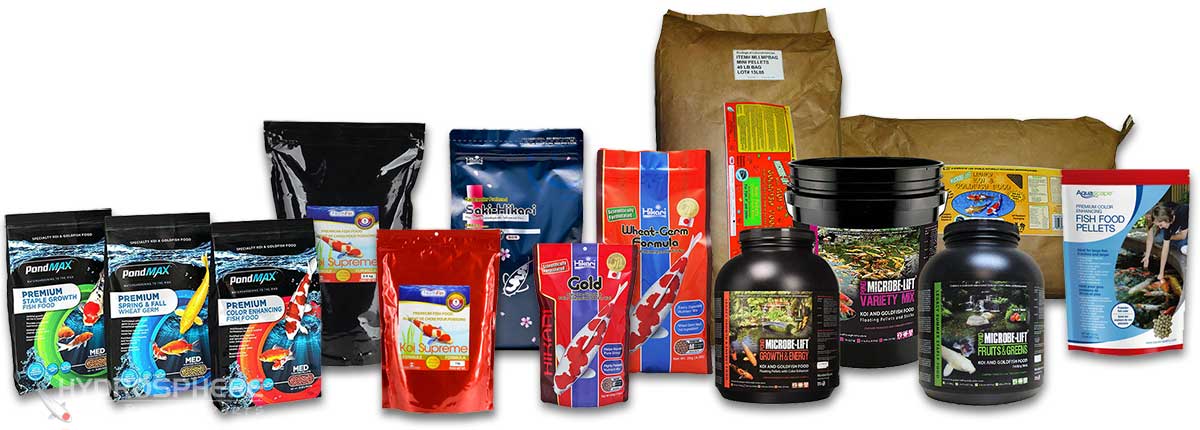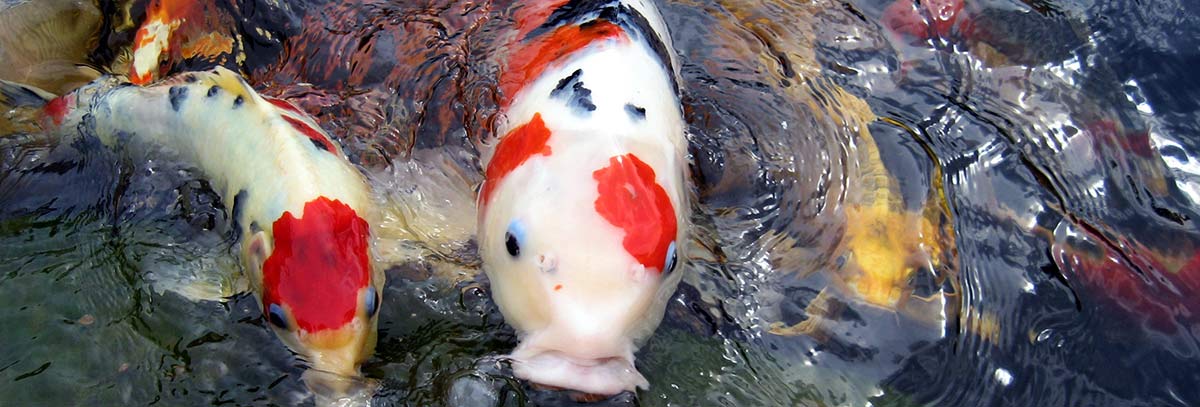Without a doubt, feeding your koi is one of the most enjoyable aspects of owning a pon. Tt’s also one of the most important things you can do to keep your koi healthy, so choosing the best koi food, or at least a quality koi food is important. Koi can live for many, many years, much longer than most people realize. The average lifespan of koi is 15-25 years, however, under ideal conditions, they can easily live for more than 50 years. In order for them to live a long healthy life, you need to provide your koi a healthy diet by feeding them a high quality food. But what are the nutritional requirements of Koi? How do you choose the best koi food?

This is especially true with koi food, and any pet food for that matter. Cheaper foods are generally made from inferior ingredients. Koi do not digest these cheaper ingredients very well, and this causes 2 problems. First, your koi are not getting a proper, well balanced diet which can lead to stunted growth, or other health issues. The second problem is related to water quality. If food is not easily digested by the koi, they produce more waste which leads to por water quality and more algae growth.
Although koi are an ornamental fish, they are descendants of wild carp. In fact, they are basically just a colourful version of wild carp and have the same nutritional requirements. Koi are omnivores, which means they eat a wide variety of foods. In the wild, carp mainly forage for their food in the mud bottom of ponds and lakes searching for insects, insect larvae, worms, plants, algae and what ever else come across their path. So, what goes into making a good koi food? What ingredients do they need to keep them healthy and live a long life?
When you look at a koi food package (or any pet food) you will see 2 important things. One is a Guaranteed Analysis, the other is a List of Ingredients.

The guaranteed analysis is a breakdown of the critical nutritional components of the food, such as protein, fat, fiber etc. Some of these, like protein, a higher value is better, while others, like fat, a lower value is better.
Here’s what to look for in koi food:
The ingredients used to make a koi food is the most important aspect of koi food. Very inexpensive koi foods tend to have poor quality ingredients, or ingredients that just aren’t adequate for koi.
The first 3 ingredients on the List of Ingredients make up the bulk of the food, so you should pay close attention to these ingredients. Like all food labels, the ingredients are listed in order of predominance, which means whatever ingredient is used most in the food is fist on the list. For example:
The largest component of koi food goes into making up the protein content that koi require, and is usually comprises the first and/ or second ingredients listed on the label. Protein makes up the largest proportion of the cost of food, so some manufacturers use cheap alternatives for a source of protein. The best protein comes from aquatic sources such as fish meal, shrimp meal, krill meal etc. These proteins have the right mix of amino acids that fish need (and normally eat in the wild). Avoid foods with terrestrial animal proteins, as they do not make a good protein source for fish. There are other good alternatives, such as wheat germ, because it is easily digestible, especially in cold temperatures.
Koi Food 1
Here is a list of the first 6 ingredients from a popular brand of an ‘All Season Pellets’ koi food found in one of the big box stores:
Ingredients:
Dehulled Soybean Meal, Wheat, Wheat Middlings, Poultry by Product Meal, Hydrolyzed Feather Meal, Fish Meal,
This food contains a lot of cheap ingredients that don’t contain the nutrients koi require. And some of these ingredients are quite questionable – poultry by product meal, hydrolyzed feather meal? The best source of protein for fish – fish meal – is the 6th ingredient on the list, so you know there really isn’t very much of it.
Koi Food 2: Northfin Koi Supreme
Now take a look at the ingredients of a quality koi food like Northfin Koi Supreme Diet, made here in Canada:
Ingredients:
High DHA Omega-3 Whole Herring Meal, Whole Sardine Meal, Whole Antarctic Krill Meal (Euphausia Superba), Wheat Flour, Organic Kelp (Laminariales), Spirulina
As you can see, this food contains all high quality ingredients, including 2 different types of fish meal, and krill meal making up the bulk of the food.
High Quality Ingredients:
Other Good Ingredients:
Ingredients to Avoid:
Another thing to watch for is the actual cost of the food ie. how much food do you get for the price? A very popular brand of food that sells mainly pond sticks, with lower protein levels and very basic ingredients. Their food seems to be a good value, you get quite a large bag for a reasonable price. But if you take the time to compare the weight of the bag to a similar sized bag of another brand, it’s usually about ½ the weight. If you calculate the cost per pound, the pond sticks are usually much more expensive than a good brand with nutrient dense feed and better ingredients. In the end, you end up paying more money for an inferior koi food.
We often get asked if trout pellets are a good food for koi and goldfish. The answer is definitely no.
While trout food is cheaper than koi food and also has high protein levels, it is not meant for koi. Trout food is designed to grow trout as fast as possible as cheap as possible. Farm raised trout don’t live very long before they are harvested, so their food isn’t formulated to promote a long life. Trout food contains high oil and fat content, and has ingredients not suited to meet the nutritional requirements of koi. If you feed koi a trout food diet for an extended period of time, they will become overweight, develop fatty deposits around their organs and will have a shortened life span.
While koi are really built for grazing on the bottom of ponds, feeding them floating pellets gives you the opportunity to see your koi at the surface of your pond when you feed them. This is important for a few reasons.
First, it allows you to monitor if you are feeding your koi the right amount of food. During the summer, you should feed your 2-4 times per day, what they will consume in about 5 minutes. If you feed a sinking food, you won’t be able to see if they ate it all in 1 minute, or if there is food left over that they didn’t finish.
Also, feeding floating pellets keeps your fish at the surface for a few minutes each feeding which allows you to get a close look at them. You can assess their overall health, inspect them for injuries, or just interact with them. If you feed a sinking food, your koi will inevitably wait for the food to sink and pick it up off the bottom of the pond and you won’t see them nearly as much at the surface.

The most important thing to take away from this article is to do a little research about what your are feeding your fish. Know what to look for in a food that will promote healthy koi, read the labels an make an informed decision. I’m not saying you need to buy the most expensive food, I don’t feed my personal koi really expensive food. But do try to stay away from the cheapest foods on the shelf.
Tips For Feeding Your Koi: